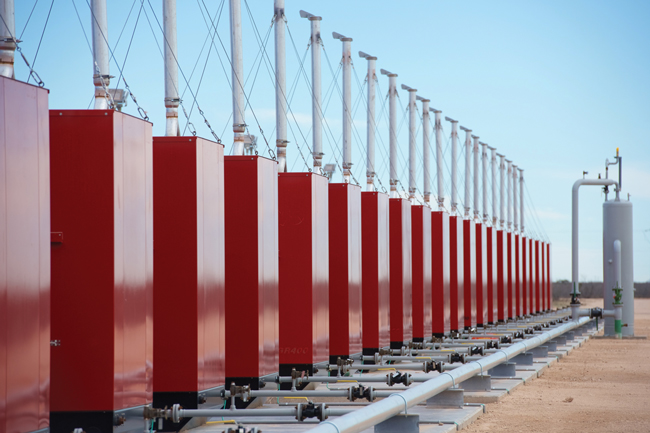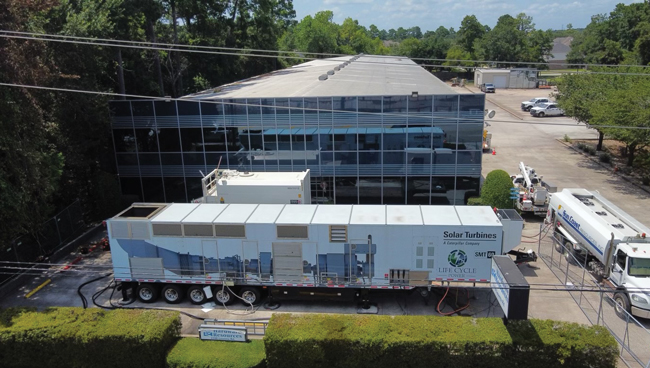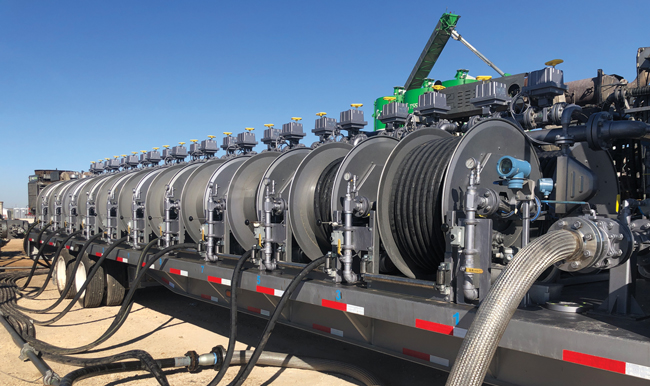
Flexible Equipment Transforms Field Gas Into Much-Needed Power
By Danny Boyd
In the Permian Basin, each barrel of sought-after crude oil comes alongside about 4 Mcf of liquids-rich associated gas. As a result, the region now accounts for a fifth of the United States’ total natural gas production.
Thanks to infrastructure bottlenecks and abundant supplies, this associated gas often gets sold for a low price or stranded. While it’s possible to get permits to flare some of the gas, the industry prefers more environmentally conscious and economically appealing solutions.
“We are trying to burn as much gas as we can in engines and turbines to create electricity, which the grid needs,” clarifies Chad Wolf, vice president of power and rental operations for Gravity. “Many operators and service companies cannot get enough electricity from utilities to meet their needs, so converting associated gas into power solves a lot of problems throughout the chain.”
With local demand for electricity growing faster than the Electric Reliability Council of Texas can expand capacity, using field gas to run generators will continue to be vital, Wolf assesses. Fortunately, he says, repurposing that gas is getting easier as gas conditioning systems and engines improve.
These natural gas generators provided by Gravity produce power for a cryogenic plant in
the Permian Basin. The company perceives growing demand for generators thanks to
abundant associated gas, rising electricity needs and environmental concerns.
Newer treatment systems come with scrubbers and auto dumps to offload stripped liquids, and modern engines’ self-tuning capabilities allow them to burn richer gas for power, Wolf illustrates. Electronic controls adjust the engine timing as Btu content changes to ensure an efficient burn and avoid pre-detonation inside the engine cylinder, he details.
Wolf oversees 11 branches in eight states for Gravity, which helps operators use field gas to run electric submersible pumps, pumpjacks and other production equipment. To improve treatment economics, he says Gravity is working on making the necessary equipment more compact.
In many applications, gas processing, reuse and power generation can be done from one trailer, Wolf says. The trailer’s inlet uses a coalescing filter to extract debris and condense water and other liquids, allowing them to be captured by a separator and pushed into a containment device through an automatic dump.
In addition to powering production equipment, Wolf notes that natural gas generators can support drilling rigs and hydraulic fracturing fleets. Given the fuel’s abundance and affordability, he predicts outlets for it outside the industry will diversify.
Cryptocurrency offers a case in point. “Bitcoin miners want the cheapest power possible because power is almost their sole operating expense,” he says. “They love it when they can generate power using a fuel that is affordable and sometimes even free.”
One bitcoin mining facility already has been built between Gravity’s Odessa, Tx., branch and a nearby, permanent gas-fired power plant, Wolf mentions. He says he sees more coming.
AI Amplification
Thanks to investments in artificial intelligence, interest in the Permian Basin’s abundant natural gas supplies may rise dramatically in the years ahead, suggests Geoff Bland, vice president of business development for Life Cycle Power. While that may strengthen natural gas prices, he warns that it could slow efforts to electrify oil field operations by creating competition for turbines and other power generation equipment.
“We are already seeing lead times for turbines lengthen, with some reaching two years,” he says. “For the data centers that perform the computing behind artificial intelligence, natural gas offers a compelling combination of reliability, affordability and low emissions.”
Gas-powered turbines can be a great way to generate power for hydraulic fracturing fleets, data centers and other power-intense applications, says Life Cycle Power. The company explains that turbines are sufficiently flexible to run on relatively rich gas and environmentally friendly enough to deliver significant capacity without exceeding air quality limits.
In the long run, Bland says demand from data centers may help companies justify investments in research, infrastructure and equipment that ultimately benefit oil and gas.
Some of the most exciting innovations, Bland argues, add mobility to packages that traditionally require extensive setup time. With the correct fueling package, mobile turbines can provide as much as 56 megawatts of power without needing complex exhaust gas treatment, Bland shares. As power needs increase, he predicts that companies will boost capacity by developing mobile catalyst systems.
The difference between natural gas-powered equipment and traditional generators can be stark, Bland relates. In many areas, a diesel-powered system can supply 8-10 megawatts before air quality permits restrict capacity additions. Comparable natural gas engines can generate substantially more power with fewer emissions, but even they top out between 15 and 25 MW under Title V air permits. According to Bland, turbines’ ability to reach 56 MW without exhaust treatment and as much 300-400 MW with a catalyst makes them the most cost-effective and environmentally compliant solution for high-horsepower applications.
Combined cycle generation, which involves harnessing the heat and steam in the exhaust to increase output, may expand capacity even more, Bland envisions.
“If we can integrate combined heat and power cogeneration into microgrids, their efficiency will go up significantly,” he says. “At the moment, the technology is restricted to fixed facilities. However, it may be something people look at mobilizing so it can be deployed temporarily and moved around as needs change.”
Turbine mobility alone already has simplified field generation, Bland mentions. Earlier, turbines dispatched to the field could take anywhere from several days to a couple months to install, depending on configuration and capacity. “Now we frequently decommission one site, move the equipment to the next location and finish setup in one or two days,” he says.
The company’s mobile systems have the flexibility to burn rich gas with limited pretreatment, Bland reports. “We have done everything we can to maximize turbines’ versatility,” he says. “The goal is to turn the lowest-cost fuel the customer can provide into dependable power.
“With proper maintenance, turbines can be extremely reliable,” he assures. “Today, we achieve an uptime above 99.9%.”
Natural Gas’ Ascent
As the industry gets better at processing produced gas in the field and transporting natural gas to site from nearby outlets, the potential for gas to displace diesel will grow, says Richard Bradsby, president of Liberty Power Innovations in Denver. He predicts that many applications will move from dual-fuel equipment to natural gas alone.
“Natural gas offers substantial savings compared with diesel, so running entirely on natural gas is a great marriage between a financial benefit and an emissions intensity benefit,” he explains.
Many electric frac fleets run entirely on power generated by burning natural gas, Bradsby relates. While electric fleets theoretically can tap into utility grids, those grids typically lack the necessary capacity.
“Frac site operations require 20-25 MW of power or more, which is a significant power draw,” Bradsby explains. “For perspective, depending on how power consumption is measured, that is equivalent to the power needed by a small town of 15,000–20,000 people.”
Natural gas’ potential to provide vital power to numerous sectors inside and outside the oil and gas industry is spurring research into better treatment and transportation techniques, observes Liberty Power Innovations. To optimize natural gas use, the company indicates it is combining such research with vertically integrated services that span everything from field gas treating and processing to compressed natural gas transportation and power generation.
To supply power with minimal fuel consumption and emissions, Bradsby says, Liberty has vertically integrated its fueling and power services with compressed natural gas transportation and field gas processing and treating services. The goal is to maximize diesel substitution, which the company tracks in real time through live frac job streaming.
As part of the integrated service, CNG is transported from compression loading facilities at nearby interstate pipelines or the tailgates of nearby processing plants, Bradsby describes. He says the company is building fueling capabilities in various basins, including the Permian, where it has facilities in Midland and Orla, Tx.
Ongoing research is investigating ways to generate more power from the gas available from nearby wells or gathering systems, Bradsby says. Ultimately, he envisions, such gas may supply enough fuel for generation feeding several frac fleets at a time.
A key component of that effort is removing natural gas liquids from the incoming gas stream as efficiently as possible so it can run generators that need dry gas with higher quality specifications than dual fuel engines, Bradsby assesses. He notes that these systems frequently rely on mechanical refrigeration or passing the gas through a valve to trigger the Joule-Thompson effect, which cools the gas as pressure drops, allowing the liquids to condense out.
The expertise and logistics of providing gas to remote locations that enable excess gas to power oil field equipment can be applied in other sectors as well, Bradsby reports. Beneficiaries include municipalities and rural electric cooperatives, new industrial developments, data centers, mining companies and disaster relief efforts.
Ramping Up
The industry’s search for creative ways to use gas inside and outside the industry is driving demand for treatment equipment and tube trailers, observes James Barr, vice president of sales for J-W Power Co., which manufactures compression and processing equipment and systems.
To meet that demand, Barr reports that J-W Power has stepped up production of its field gas conditioners. He says the propane and other liquids extracted from the gas stream frequently pay for conditioning equipment.
Once the gas has been treated, loading stations will compress it to several thousand pounds of pressure to fill CNG trailers. These trailers take the gas to an offloading site for decompression, relates Rick Poorman, J-W’s corporate sales manager. The offloading sites frequently include heaters to keep the gas warm enough for use.
Since J-W Power entered the CNG market in 1993 to support CNG vehicles, compressors, tube trailers and dispensing skids have come a long way, Poorman reflects. As a case in point, he says new CNG trailers use sensors to monitor how much gas remains in the tube.
“Companies are paying to drive the trailer back and forth so they want to go to the site full and come back empty and get paid for as much gas as they can get in the trailer,” he explains. “We can fill the tube trailers, or we can compress gas and put it into a pipeline if one is available.”
In the past, Barr notes that J-W Power primarily would build skid-mounted systems. However, it is filling a growing number of orders for mobile, trailer-mounted systems as service companies increasingly rely on field gas to power equipment.
Real-Time Insight
One of the biggest challenges with using field gas to generate power is how rapidly and frequently the quality changes, says Chris Fournier, director of F3 Fuel Solutions, which is affiliated with ProFrac but plans to provide services to other companies as well. If off-spec gas goes undetected, he says it can reduce fuel efficiency and damage equipment.
To respond quickly to those quality changes, Fournier says F3 deploys analyzers that use near-infrared spectroscopy to monitor the gas stream’s Btu content in real time. The analyzers take measurements every 10-15 seconds, Fournier details. He says they have no moving parts, which makes them extremely reliable.
F3 Fuel Solutions uses infrared spectroscopy to track changes in gas quality during a job in real time. The company says its monitors’ frequent readings, as well as ongoing improvements to gas conditioning equipment, are enabling engines to run on a wider variety of field gas, which is helping operators reduce fuel costs.
Using real-time analyzers instead of gas chromatographs lets the company run a wider range of field gas, Fournier reports. With near-instantaneous quality measurements, he explains, it can push the limits from a Btu standpoint, knowing it can shut off the flow of gas immediately if the stream falls out of spec.
Before reaching a turbine or engine, field gas flows through a trailer that handles pressure regulation and liquids separation, Fournier describes. Technicians can adjust the pressures and flow rates from the operations van or a phone, he says, adding that the trailer can shut off flow entirely in an emergency.
Every reel on the trailer has dedicated flowmeters and actuator valves, Fournier mentions. Whether they are in the operations van or watching the job remotely, technicians can control which reels, and therefore engines, get gas, as well as how much each engine receives.
“During a frac stage, as pump operators are changing gears and revving pumps, the technicians can see in real time how the load changes impact the gas flow rates going to the engines,” he says. “If there is some limitation on processing, they can shut gas off to specific pumps and turn it on for others to establish a desired flow rate.
“Better treatment solutions are creating new opportunities to repurpose field gas,” he reflects. “For example, we have mobile processes for stripping out hydrogen sulfide that did not exist previously.”
For other great articles about exploration, drilling, completions and production, subscribe to The American Oil & Gas Reporter and bookmark www.aogr.com.


















